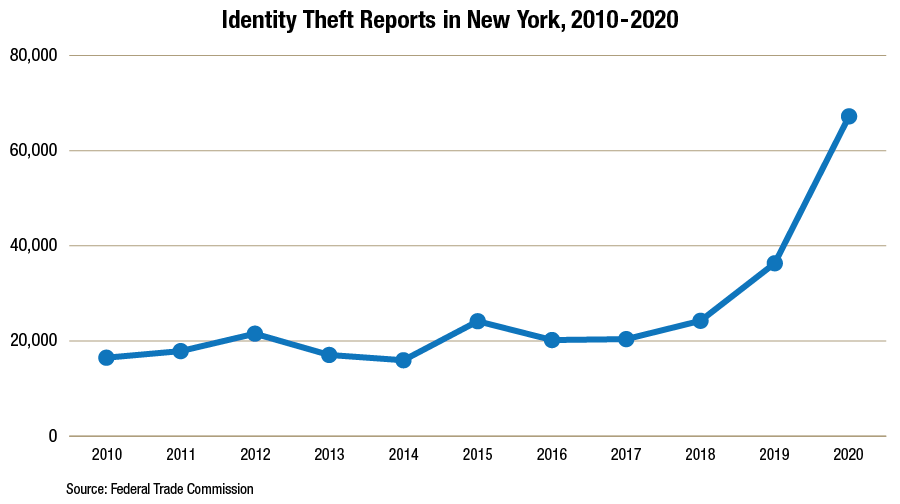DiNAPOLI: IDENTITY THEFT CASES SURGED IN NEW YORK IN 2020
More Than 67,000 Complaints to Federal Trade Commission, Up 85 Percent from Previous Year
Identity thefts in New York surged during the pandemic with more than 67,000 complaints filed statewide in 2020, which was 85 percent more than the previous year and more than four times the annual total from a decade earlier, according to a report released today by New York State Comptroller Thomas P. DiNapoli.
The New York City metropolitan area had the highest rate of identity theft reports to the Federal Trade Commission (FTC) per capita at 403 reports per 100,000 people, followed by Poughkeepsie-Newburgh-Middletown (315) and Rochester (303) metropolitan areas.

“In the midst of the stresses caused by the pandemic, many New Yorkers also dealt with identity theft last year,” said DiNapoli. “Even when there’s no money stolen, resolving the consequences of stolen personal information is complicated and can take months of effort. Often the pain is really felt later, when victims have trouble getting a job, renting an apartment, or getting a loan because their identity was stolen. We should all take common-sense steps to keep personal information confidential, and companies must do more to protect consumers from identity theft.”
Credit card fraud was the most common type of identity theft reported to the FTC in 2020, with nearly 25,000 New Yorkers reporting someone misused their information on an existing credit card account or to open a new account. More than 3,600 identity theft reports related to COVID-19 were reported in the state, with two-thirds connected to unemployment benefits or other government programs, according to the FTC.
Identity thieves also stole individuals’ personal information to get prescription drugs, obtain medical services or medical insurance coverage and for a variety of other purposes.
Identity thefts have surged in New York over the past decade, but reported arrests and convictions have changed little from year to year. The 543 arrests by state and local authorities in state Fiscal Year 2019-20, as reported by the state’s Division of Criminal Justice Services, were the fewest of the last decade. Among counties, arrests and convictions were most frequent in those with the largest population. Albany County led New York State in arrests and convictions per 100,000 residents in SFY 2019-20.
Nationwide, reported losses from identity theft totaled $15.1 billion in 2018. The U.S. Department of Justice’s data does not breakdown losses to identity theft by state, but losses by New York residents would be more than $800 million if they are similar to its share of identity theft reports to the FTC that year (about 5 percent).
COVID-19 Identity Theft
The COVID-19 era has been marked by new varieties of financial fraud, including new identity theft scams. Although the full impact of the pandemic on the problem is not yet known, New Yorkers should be aware of potential scams and guard against them.
The FTC has compiled identity theft complaints related to COVID-19 for 2020 through mid-March 2021, reporting 3,617 in New York. Of the state’s identity theft reports, about two-thirds (2,375) were related to information misused to try and get a government document or benefits such as economic relief checks or unemployment insurance.
According to the FTC, imposters are filing claims for unemployment benefits using the names and personal information of people who have not filed claims. People learn about the fraud when they get a notice from the state unemployment benefits office or their employer about their supposed application for benefits. As of late April 2021, the state Department of Labor (DOL) said it had identified over 1.1 million fraudulent unemployment benefit claims during the COVID-19 pandemic, preventing more than $12.3 billion in stolen benefits.
DiNapoli’s office began an audit of the DOL in February. His office first conducted an assessment of the risk of potential identity theft fraud since the beginning of the pandemic, which included looking at complaints, large increases in payments, new programs and criteria, and changes to the internet technology. This assessment found numerous red flags that led DiNapoli’s office to launch a full audit.
Identity thieves have also attempted to leverage news of government COVID-related stimulus payments by posing as someone from an official organization and asking for personal or financial information. They have also tried to exploit pandemic fears by asking victims to pay out of pocket to get a COVID-19 vaccine or to put their name on a vaccine waiting list and, in the process, take their Social Security, bank account or credit card information.
Private businesses that collect and maintain personal information must redouble their efforts to safeguard such data, DiNapoli said. He called on social media companies to promote best practices and proactively educate users about ways to keep private information confidential.
DiNapoli recommends the following actions, among others, to help prevent becoming a victim of identity theft:
- Carry only the credit and bank cards you need.
- Use two-factor authentication for online security where possible.
- Use a password manager or strong passwords, including a mixture of capital letters, numbers, and symbols, and change passwords frequently.
- Check bank or credit statements regularly.
- When online shopping, look for indications that the site is secure, such as a secure URL that begins with “https” (rather than “http”) and a lock icon near your browser’s location field.
Report
The Increasing Threat of Identity Theft
Posted: May 13th, 2021 under Law Enforcement News, State Government News.
